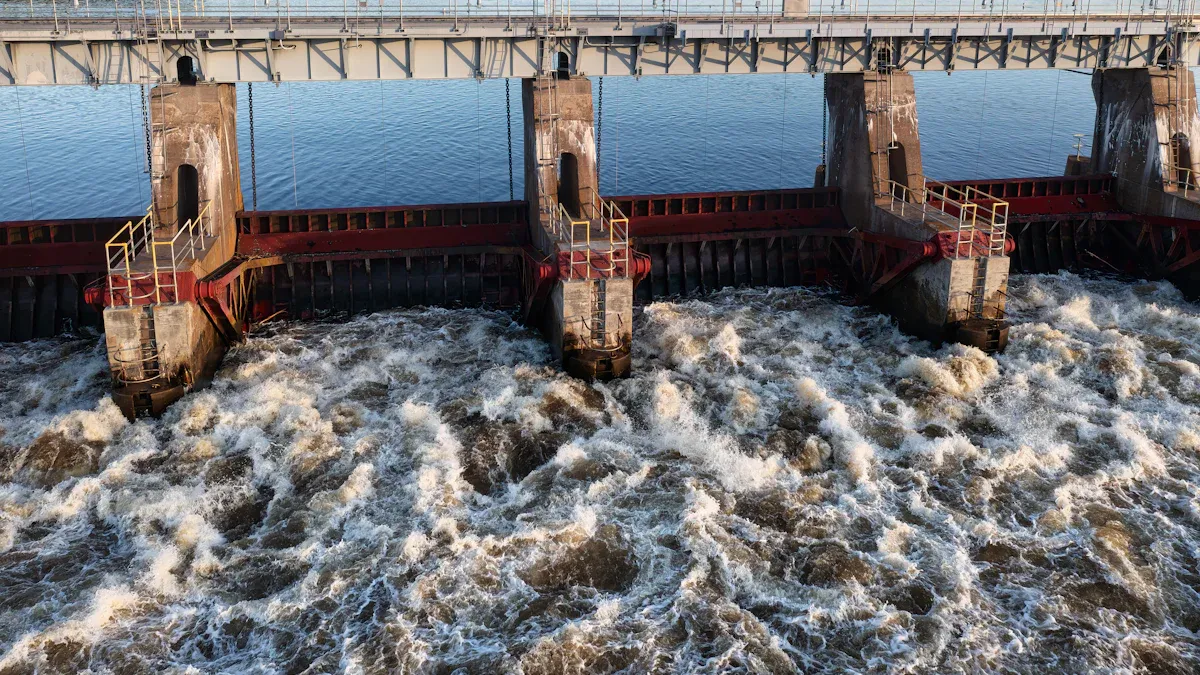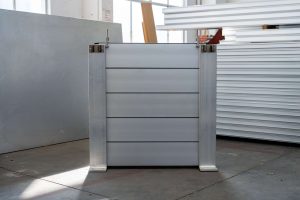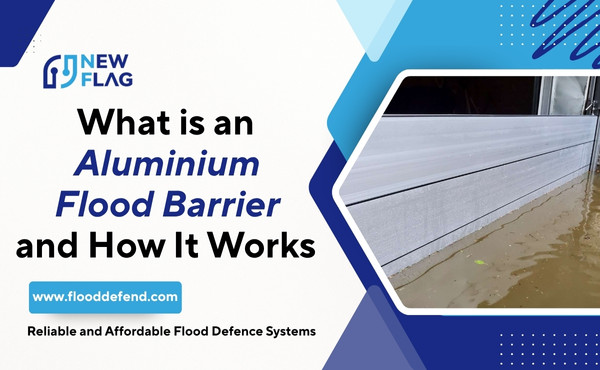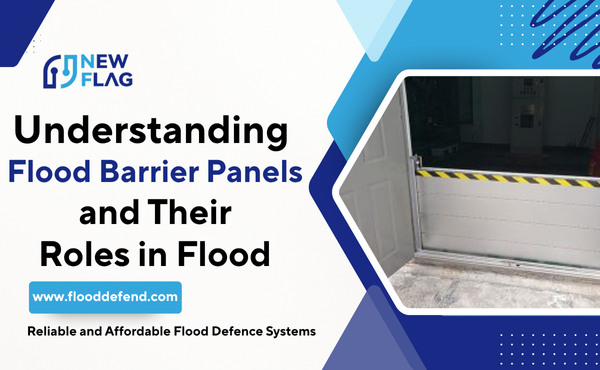
A modern flood barrier uses advanced materials to block or redirect water during a flood. Common options include aluminum, glass, high-strength plastics, rubber, and composite materials.
People often see several main types such as demountable barriers, glass wall barriers, automatic systems, temporary barriers, and flood gates. Each flood protection barrier serves a unique role in a flood defense system.
Choosing the right flood protection solution helps protect property and prevent damage.
- Aluminum and metal alloys offer strength and durability.
- Glass and transparent materials allow visibility while providing reliable flood protection.
Why Flood Barrier Material Matters
Effectiveness and Durability
When you choose a flood barrier material, you make a decision that affects how well your flood barriers perform. You want a flood protection barrier that stands strong against rising water and lasts through repeated use.
Materials like aluminum and steel resist corrosion and offer long-term protection. PVC and polyethylene give you lightweight options that work well for portable flood barriers. Concrete and composites provide solid, durable solutions for permanent installations.
Tip: If you need effective flood protection for your home or business, look for materials that can handle high water pressure and harsh weather.
You should also think about how each material reacts to different conditions. For example, steel can rust if you do not maintain it properly.
Polypropylene and polyethylene resist chemicals and UV rays, so they last longer outdoors. Water-filled barriers use tough PVC fabric that flexes under pressure but stays strong. These choices help you achieve reliable flood prevention and protect your property for years.
Suitability for Different Environments
Flood barriers must fit the environment where you plan to use them. You might need portable flood barriers for quick deployment in residential areas.
Aluminum and composite barriers work well for commercial spaces that require an ideal flood barrier with a sleek look. Concrete barriers suit places with frequent flooding because they stay in place and withstand heavy water flow.
Here is a simple table to help you match materials to environments:
| Environment | Recommended Material | Key Benefit |
|---|---|---|
| Residential | Polyethylene, PVC | Lightweight, easy to move |
| Commercial | Aluminum, Composite | Durable, attractive |
| High-risk zones | Concrete, Steel | Maximum strength |
You improve your flood protection measures when you select the right material for your setting. Each option offers unique advantages, so you can find the best fit for your needs.
Materials of Flood Barrier

Aluminum and Metal Alloys
Aluminum and metal alloys give flood barriers strong resistance against water pressure. These materials do not rust easily, so they last for many years. Workers can install aluminum panels quickly because they are lightweight.
Metal alloys add extra strength for larger flood protection systems. However, metal can dent if hit by heavy objects. People often choose aluminum for demountable barriers because it is easy to reuse.
| Material | Strength | Durability | Reusability |
|---|---|---|---|
| Aluminum | High | High | Excellent |
| Metal Alloy | Very High | Very High | Excellent |
Glass and Transparent Materials
Glass and transparent materials help keep views open while blocking floodwater.
Laminated glass resists breaking and can handle strong impacts. These materials work well for permanent barriers in public spaces. Glass needs careful installation to prevent leaks.
Cleaning glass panels is simple, but replacing broken panels can cost more. For more details on barrier types, see Types of Flood Barriers.
High-Strength Plastics
High-strength plastics offer flexibility and toughness. These materials resist chemicals and do not rust.
Workers use plastic panels for temporary flood barriers and flood gates. Plastics weigh less than metal, so people can move them easily.
Some plastics may crack in extreme cold or under heavy force. Most plastic barriers can be reused several times.
Rubber and Flexible Materials
Rubber and other flexible materials create barriers that bend and stretch. Inflatable flood barriers use rubber tubes filled with water or air.
These barriers set up quickly and fit uneven ground. Rubber resists tearing and handles repeated use. However, sharp objects can puncture rubber, so users must check for damage after each flood event.
Water-Filled PVC Fabric Flood Barriers
Water-filled pvc fabric flood barriers offer a modern solution. You fill these barriers with water when a flood threatens. The tough pvc fabric holds the water and forms a strong wall.
You can deploy these barriers quickly. They work well for both homes and businesses.
Water filled barriers adapt to uneven ground. You can stack them or curve them around corners. This flexibility makes them an ideal flood barrier for many situations. Some water-inflated barriers use vinyl-coated polyester for extra durability.
Tip: Water-filled barriers are reusable. You can empty and store them after the flood passes.
Concrete and Composite Barriers
Concrete barriers provide the most durable flood protection barrier. You often see them in high-risk zones or places with frequent flooding. Concrete stands up to heavy water flow and lasts for years. These barriers require professional installation, but they offer long-term security.
Composite barriers combine materials like fiberglass and resin. They weigh less than concrete but still provide strong protection. You can use composites for both temporary and permanent barriers. Some composite barriers include rubber seals to improve water resistance.
If you need an ideal flood barrier for a busy area, consider composites. They blend strength with a modern look.
Other Barrier Types and Materials
You may also encounter soil filled barriers. These barriers use earth or sand to block water. They work as a quick fix but do not last as long as modern options.
Rubber seals play a key role in many types of flood barriers. They stop leaks and improve the fit between barrier sections. You should look for barriers with quality seals for better flood protection measures.
Remember: The right flood barrier material helps you protect your property and community. Choose the type that matches your environment and risk level.
By understanding the types of flood barriers, you can make smart choices for your home or business. Modern materials give you more options for effective flood protection than ever before.
Choosing Right Flood Materials Protection
Matching Materials to Risks
Not all barriers materials work for every situation. People should match the barrier materials to the level of risk and the property’s layout.
For frequent, high-water floods, permanent barriers like glass walls or automatic systems offer strong defense. Temporary barriers, such as sandbags or inflatable tubes, suit short-term or unexpected floods. Demountable barriers work well for places with regular but not constant flood threats.
Aluminum flood gates protect wide entrances or underground spaces. The choice of material also matters. Aluminum and composites last longer, while rubber and plastics allow quick setup.
Conclusion
Flood barriers come in many types and use different materials. Each barrier works best for certain flood risks and property layouts.
People should think about installation, reusability, and maintenance before choosing a flood protection solution. A professional can help with complex or high-risk flood situations. The right choice helps protect property from flood damage and keeps people safe.






